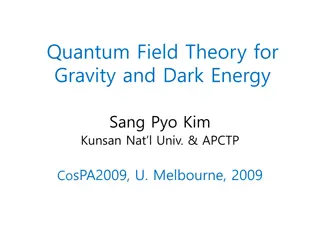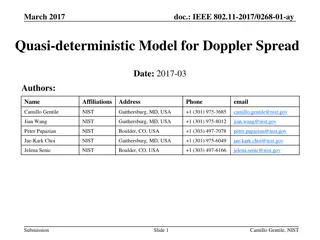Exploring Parameterized Post-Friedmann Framework for Interacting Dark Energy
Dive into the complexities of considering interacting dark energy (IDE) using a parameterized post-Friedmann framework. Learn why IDE is essential, how to detect couplings, calculate perturbation evolutions, and address instability issues. Explore the one-parameter extensions like wCDM and I.CDM, and understand the challenges of detecting the fifth force in cosmology.
Download Presentation

Please find below an Image/Link to download the presentation.
The content on the website is provided AS IS for your information and personal use only. It may not be sold, licensed, or shared on other websites without obtaining consent from the author. Download presentation by click this link. If you encounter any issues during the download, it is possible that the publisher has removed the file from their server.
E N D
Presentation Transcript
Parameterized post-Friedmann framework for interacting dark energy Xin Zhang Northeastern University
Contents Why IDE? How to consider IDE? How to detect the coupling? How to calculate perturbation evolution of IDE? Early-time large-scale instability problem Solution: PPF for IDE Exploration of whole parameter space Tests of I CDM
Why IDE? A better question: Why not consider IDE? ----- Actually, no interaction between DE and DM is a specific assumption. Some advantages in theoretical aspect, e.g., alleviating the coincidence problem. But this is secondary. More important issue: How to detect this fifthforce , or falsify it. Current data favor a 6-parameter base CDM model. But this model must need extension. From the perspective of DE, the simplest one-parameter extension: (1) wCDM (2) I CDM.
How to consider IDE? Lack micro-physical mechanism, so can only consider it from phenomenological perspective. Usual: Assume a form for the energy density transfer rate Q. In a perturbed universe, there is also a momentum density transfer rate. Calculate cosmological consequences!
How to detect the coupling? Impossible to directly detect such a fifthforce , can only indirectly detect it (global fit). Calculate how it affects cosmological evolution (expansion history and growth of structure). This requires us to study cosmological perturbations. DE is not a pure background, so it also has perturbations. How to consider the perturbations of DE?---Important for understanding the nature of DE.
Calculate the perturbation evolutions energy-momentum tensor metric Einstein eqs continuity and Navier-Stokes eqs
3 variables ( , v, p), 2 equations. Needs an additional equation to relate pressure and density perturbations to complete the eqs system. That is an equation for sound speed. For DE, adiabatic sound speed is not physical (ca2<0). One has to impose by hand a physical sound speed for DE, and view DE as a nonadiabatic fluid.
Interacting dark energy model a covariant model:
A concrete example Newtonian gauge early times: Einstein eqs: photon, baryon, neutrino DE & DM
Early-time large-scale instability Once calculate perturbations: For most cases, the curvature perturbation is divergent at early times (superhorizon). Instability: w>-1
The pressure perturbation defined by sound speed involves nonadiabatic mode. The nonadiabatic mode in uncoupled DE models will decay away, but in IDE models sometimes will rapidly grow, leading to blowup of curvature perturbation. This reveals our ignorance about nature of DE. We actually do not know how to treat the perturbation of DE. Way out: establish an effective theory based on the basic facts of DE---PPF. This generalizes the PPF of uncoupled DE of Fang, Hu & Lewis (2008). arXiv:1404.5220
Whole parameter space can be explored Prefer < 0: DE DM (1.6 ) = O(10-3), precision 60% CMB itself can constrain well RSD do not improve significantly
Previous works assume w>-1 and >0, so the fit result is positive O(10-3), which is wrong! RSD break degeneracy and improve fit significantly RSD favor <0 at 1.5 , O(10-2) w is around -1: I CDM model
Summary 6-parameter CDM is currently favored by data, but extensions will be needed when facing future highly accurate data. Some fifthforce might exist between DE and DM, which should be tested. To know how to consider DE perturbations is important for understanding the nature of DE. Instability in IDE reveals our ignorance about the nature of DE. We actually do not know how to treat the perturbation of DE. We thus establish a PPF framework for IDE. Whole parameter space of IDE can be explored based on PPF. Various models can be constrained by data. Testing I CDM: towards CDM. Future high-precision data are important: a long way ahead.























